A Comprehensive Overview of Shopify Schema, Its Types, Importance and Implementation
E-Commerce has undeniably become more and more popular these days. As the internet and internet-enabled gadgets get more readily available and easily accessible, more and more people are also now turning online for various activities. One of these activities is online shopping. Online shopping or e-commerce provides great advantages to consumers. One advantage is that it offers them a more convenient and easier way to purchase what they need with just a few clicks, any time they want, and anywhere they are as long as they are connected to the internet. Not only that, products and services online tend to be less expensive than those similar brands that are sold at local brick-and-mortar stores. Also, consumers no longer need to drive or commute to get to the local store, allowing them to save more on fuel and fare costs.
E-commerce is the New Way of Doing Business.
Know the Reasons with proof
But it is not only the consumers who can benefit from online shopping. The retail industry also gained many benefits from this modern way of doing business. These benefits include convenience, flexibility, a better way of reaching the target market, being visible and available to a wider pool of prospective customers, and lower overhead costs, to name a few. To build and grow your online business, you need more than just having excellent quality and affordable products, great marketing strategies, and a nice E-Commerce website. No matter how great your product or online store is, you can’t make a sale or close a deal if your target customers do not know of your existence. You need your target market to find and know you first before you can sell your products or services.
The rule of thumb when it comes to digital marketing is “to be in a place where your target markets gather”. These days, businesses can find customers either on different social media sites or search engines. If you want to be visible on these platforms, you need the help of search engine optimization or SEO professionals. One of the most helpful structured data markups for SEO that you can use for your E-Commerce websites today is the Shopify schema.
Table of contents
What is Shopify Schema?
Schema is a structured data vocabulary that is usually added to your HTML to refine how Google and other search engines read, analyze, and display your web page in SERPs. It defines the type of data that can be included or is included inside your structured data. It also describes the elements of your E-Commerce website. For instance, it defines the data included in your product pages like the name of the product, the product variant, color, SKU, and other relevant information.
Related Terms:
- Schema.org. It is a reference website that defines all the different kinds of data available in Schema. Schema.org aims to standardize HTML tags used to create rich results for your E-Commerce website or pages.
- Structured data. It is the language used in web pages to make Google and other search engines like Bing find you, and analyze or understand what your E-Commerce website is all about or what products you offer.
- Schema markup. It is a type of microdata that helps improve description when added to your Shopify store pages.
Though these terms are closely related to each other and mean almost the same, they differ in some ways. The above descriptions will give you an overview of the primary differences between these terms.
Why does Schema matter to your eCommerce Store?
Schema is practically a kind of rich snippet that can help you directly tell search engines relevant information like who you are, what content you provide, what are your products or services, and what you do. By implementing a well-configured schema, your potential customers will not only see a snippet of text or information about your E-Commerce store but also all-important, relevant information about your products or services as well. This will help improve the overall experience of your potential customers and boost your click-through rate. But why should you choose to implement Schema on your Shopify store? Read on to know more.
Why Should you Implement Shopify Schema on your Shopify store?
Though implementing Schema on your Shopify store does not directly help improve your search engine ranking or guarantee that you will be displayed in rich results, it can greatly help improve how search engines see and present your pages on SERPs. Below are some reasons why you should implement Schema in your Shopify store.
- Helps you build authority
Shopify Schema enables you to provide search engines with added information about your business and products, making it easier for them to know you. With better language, you are able to communicate with search engines more directly, clearly, and effectively. The more you communicate with search engines and the more relevant information you give them about you and your products, the more people will see you as an authoritative brand.
Apart from that, customers, in general, are motivated by price. Though they pay attention to which brand or E-Commerce shop they want to make a purchase, they care about the price. Consumers nowadays are looking for convenience and accessibility. If you have the price and other relevant details about your product like whether it is in stock or not, variations available, and description, consumers viewing your information on search engines will more likely click your page than those that don’t display such information. In other words, Shopify Schema provides rich information to the Google bots that what users are exactly looking for.
- Offers fast response and flexibility
Its fast response rate and flexibility in terms of modifying prices and availability are among the top reasons why a lot of Shopify shops love Schema. If you are offering products or services at a fixed price and they are not subject to availability issues like made-to-order types of merchandise, it is fair enough to use static product pages. However, if you are into the retail business and your product prices and availability varies and you need to change them from time to time, implementing Shopify Schema will make it easier and quicker for you to perform the such modification.
- Helps you build trust with product reviews and comments
Product reviews and comments matter as they affect how your potential customers perceive your brand and product. According to the statistics report entitled “How do online customer reviews affect your opinion of a local business?” by Statista Research Department, published on February 9, 2021, 94% of the surveyed U.S. online customers revealed that they like to use businesses with positive reviews. In the same survey, 92% of respondents stated that they are less likely to use and patronize businesses with negative reviews. By using Shopify Schema, you can be able to add positive product reviews to your displayed search engine results. This will help encourage more people to click on your Shopify product site.
- Helps with PPC
Mismatched prices can get you in trouble. It will destroy your credibility and integrity. It will also cause you to get penalized by Google. If you are running a PPC campaign, and your product prices are constantly changing, Shopify Schema will help make sure that your prices are up to date, accurate, and competitive for your consumers.
What are the Different Shopify Schema Types?
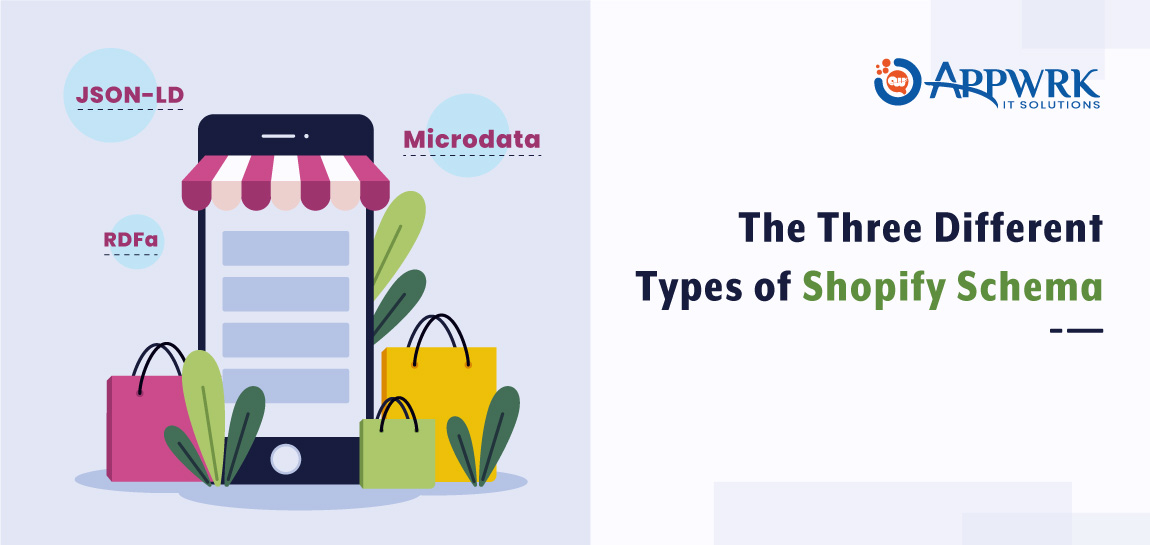
There are three main types of Schema that you can implement on your Shopify website. These are:
- JSON-LD
- Microdata
- RDFa
Below is a Quick Comparison Between These Three Shopify Schema Types.
JSON-LD
JSON-LD is a lightweight JSON-based Linked Data format with multi-dimensional arrays. It is simpler and easier to implement as compared to microdata and RDFa. JSON-LD is also easy for humans to read and write. You just have to paste the Schema markup within the HTML document of your Shopify site. However, if the markup is added manually, implementing JSON-LD can be quite challenging. JSON-LD is based on JSON format and is supported and recommended by major search engines like Google, Yandex, and Bing for implementing markups. It is available in different programming environments including Javascript, Python, Ruby, Go, Java, Rust, C#, PHP, Erlang/Elixir, and TypeScript.
This Linked Data format will annotate elements on a page and structure the data as well as connect and organize disconnected and messy data. This helps Google disambiguate elements and organize facts surrounding entities. The end result is a better, more organized web. One of the primary benefits of using JSON-LD over other types is that you don’t have to place it inline. Instead of embedding it in the <body> of a page, you can add it in a <script> tag and position it anywhere within the page. So, many programmers prefer JSON-LD on their Shopify store as it facilitates easy Schema implementation.
Here’s a simple example of JSON-LD.
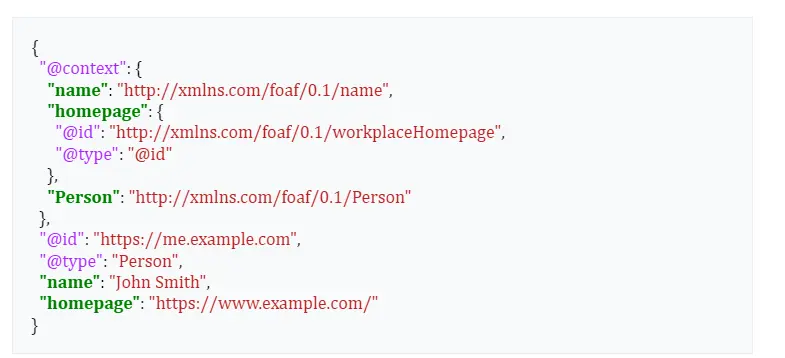
Microdata
Microdata is a set of tags that uses in-line markup syntax and is directly added to the HTML elements. It enables webmasters to mark up an E-Commerce page. This WHATWG HTML specification can be employed to nest metadata within the current content of your Shopify page. Microdata provides you a good way to tell the search engines the information about the products you have listed on your Shopify website. To provide search engines with the right information about the products you have listed on your Shopify website, you have to add some extra tags to your HTML. Each of the tag sets has to contain:
- Itemscope– this can help define the item being referenced.
- Itemtype– this can help define the type of item that the microdata is referencing.
- Itemprops– this is used to markup the properties found on the page.
Tagging with Microdata is simpler. This makes it easier to implement Schema markup manually as opposed to JSON-LD on your E-commerce Shopify store. However, if you are not well-versed with programming, implementing markups with Microdata can be really complicated. Though it is often used in the body section, you can also use it in the head.
Below is a sample Microdata markup with Schema.org.
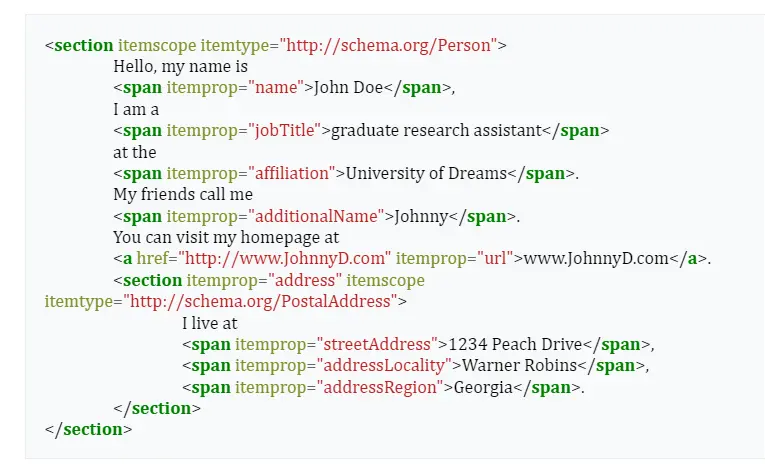
RDFa
RDFa stands for Resource Description Framework in Attributes. It is an open-community HTML5 extension that is used to markup metadata within Shopify website web pages. It uses in-line markup syntax with the existing HTML just like Microdata. RDFa is commonly added in the head and footer sections of the web page. Web services and search engines like Google use RDFa to generate improved search listings. It can help your E-Commerce website gain better visibility online, thus, making it easier and quicker for your target market to find you, especially on search engines. RDFa does not only work in HTML5 but in other Linked Data markup HTML-like languages as well including XML documents, XHTML1, HTML4, and XHTML5 documents, and SVG documents. Thus, implementing Schema with RDFa on your Shopify site improves sharing of relevant information across the web.
Below is a sample of a complete XHTML+RDFa 1.0 document.
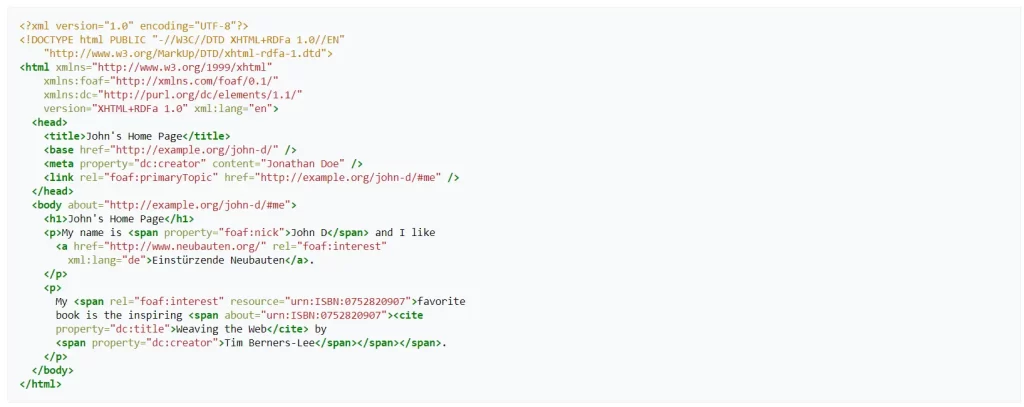
How to Implement Shopify Schema?
There are two different ways to add and implement Schema on a Shopify E-Commerce website. You can either do it manually or with the help of a plugin.
A> Manual Schema Implementation using the recommended JSON-LD
- Step 1:
The first thing you need to do is to create your Schema markup for your Shopify store. You can use the tool called Schema markup builder available at technicalseo.com to generate your Organization Schema. Then, duplicate the JSON-LD.
- Step 2:
Log in to the Admin section of your Shopify E-Commerce website. Follow these steps:
Online Store > Themes > Action > Edit Code
Note: Things can become a bit intimidating here. But don’t worry because we will just be doing minimal alterations. This won’t cause any damage.
- Step 3:
Create and add a new snippet. To do it, scroll down the left navigation section and then open the snippets folder. After such, click the “Add a new snippet” button. Enter the name of the snippet file- any name will do; it depends on how you would like to name the file. For this illustration, we will name it “Appwrk”.
- Step 4:
Paste the Organization Schema you duplicated from the Schema markup builder tool into the vacant field. Then click the save button. Also, don’t forget to add the div and script tags.

- Step 5:
Add the new Schema snippet to your Shopify E-Commerce website’s homepage. To do so, first head on to the left navigation section and then look for the index.liquid file. You can find it within the template directory.

Add then enter {% include ‘snippet-name’ %}. Replace the snippet name with your snippet file name, then save. In this case, we have set Appwrk as an example name.
- Step 6:
The last step is to test if you have successfully and properly implemented the Schema markup on your Shopify site. To do so, visit the Structured Data Testing Tool of Google and then type in your E-Commerce website home page URL. Then hit “run the test”. Congratulations if the test result says that your Schema markup works. Otherwise, you may try to go back to the previous steps and see where you went wrong and then start from there.
B> Schema Implementation (JSON-LD) through Shopify Schema markup plugins
The other way of adding the Schema markup is to use a Shopify Schema markup plugin. This is quite a straightforward process and it is perfect for beginners and those who are not familiar with HTML. You can find many available Shopify Schema markup plugins that you can add to your E-Commerce website. The most commonly used Shopify Schema markup plugin is Schema Plus for SEO. Schema Plus for SEO is the most advanced automatic schema app that was developed by the former senior software engineers of Google. All you have to do is add and install the app to your Shopify E-Commerce website. Once completed, the schema will get activated. It will then begin adding the structured data in JSON-LD format to your Shopify E-Commerce website.
Endnote
In conclusion, the rise of e-commerce has revolutionized the way business is conducted, benefiting both consumers and retailers alike. The convenience, accessibility, and cost-effectiveness of online shopping have made it a preferred choice for many. However, to succeed in the competitive online market, businesses must leverage tools like Shopify Schema to enhance their visibility, improve search engine rankings, and provide a seamless experience for customers.
APPWRK offers expert guidance and support in implementing Shopify Schema, ensuring that your e-commerce venture is equipped with the right tools to thrive in the digital landscape. Take the next step towards optimizing your e-commerce strategy with APPWRK today!
Still Finding it Difficult to Implement Schema on Shopify Site?
Hire a dedicated Shopify developer!
Frequently Asked Questions
Shopify Schema is a code that markups up E-commerce content for Google, Yahoo, and other engines to know what a particular entity on the web page means for users. With Shopify Schema, merchants tag relevant information on the website like the product’s brand, color, reviews, material, and offers. The Schema in Shopify improves site visibility in front of the target audience while inviting more clicks and purchases.
Shopify Schema presets allow store owners to select theme styles already present in the Shopify platform and customize them according to their needs. To put it simply, if store owners want to change certain values in the theme style, they can define presets by setting values in the setting_Schema.json file, and these changes get saved in the setting_data.json file.
With Google’s structured data markup helper, you can enter your web page, tag data for which you want to create Schema, and generate HTML code. Further, you can add microdata to your source code and test the Schema.
Another online tool available for creating Schema is Schema markup builder by technicalseo.com.
With plugins like Schema Plus, you can create structured data and activate Shopify Schema effortlessly.
The block type is a part of the block’s Schema that returns the type mentioned in the code. A block allows the Shopify merchants to add, remove, or reorder certain content within a section. So, the block type enables merchants to specify the cases like what to display if a user enters a value or data.
About The Author


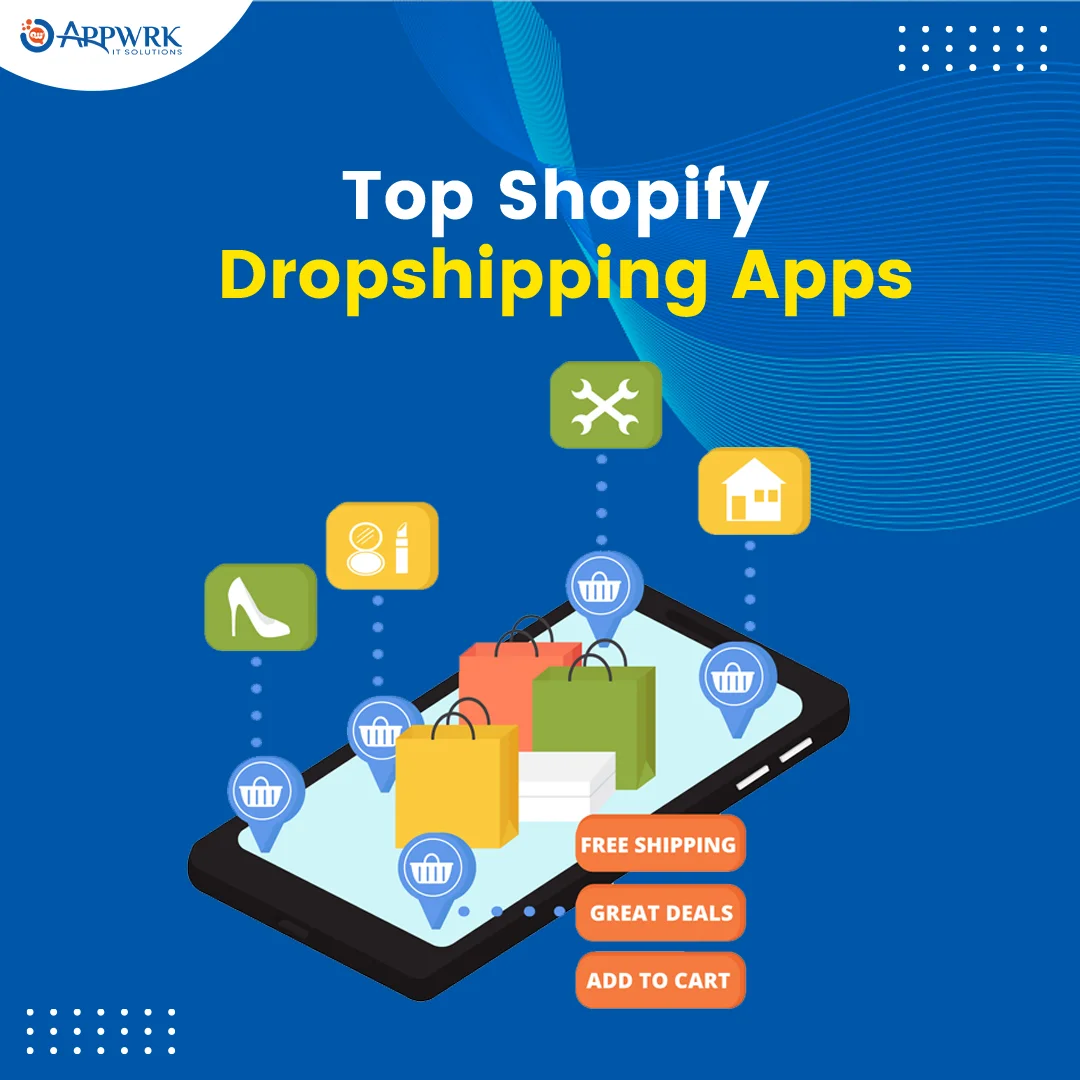


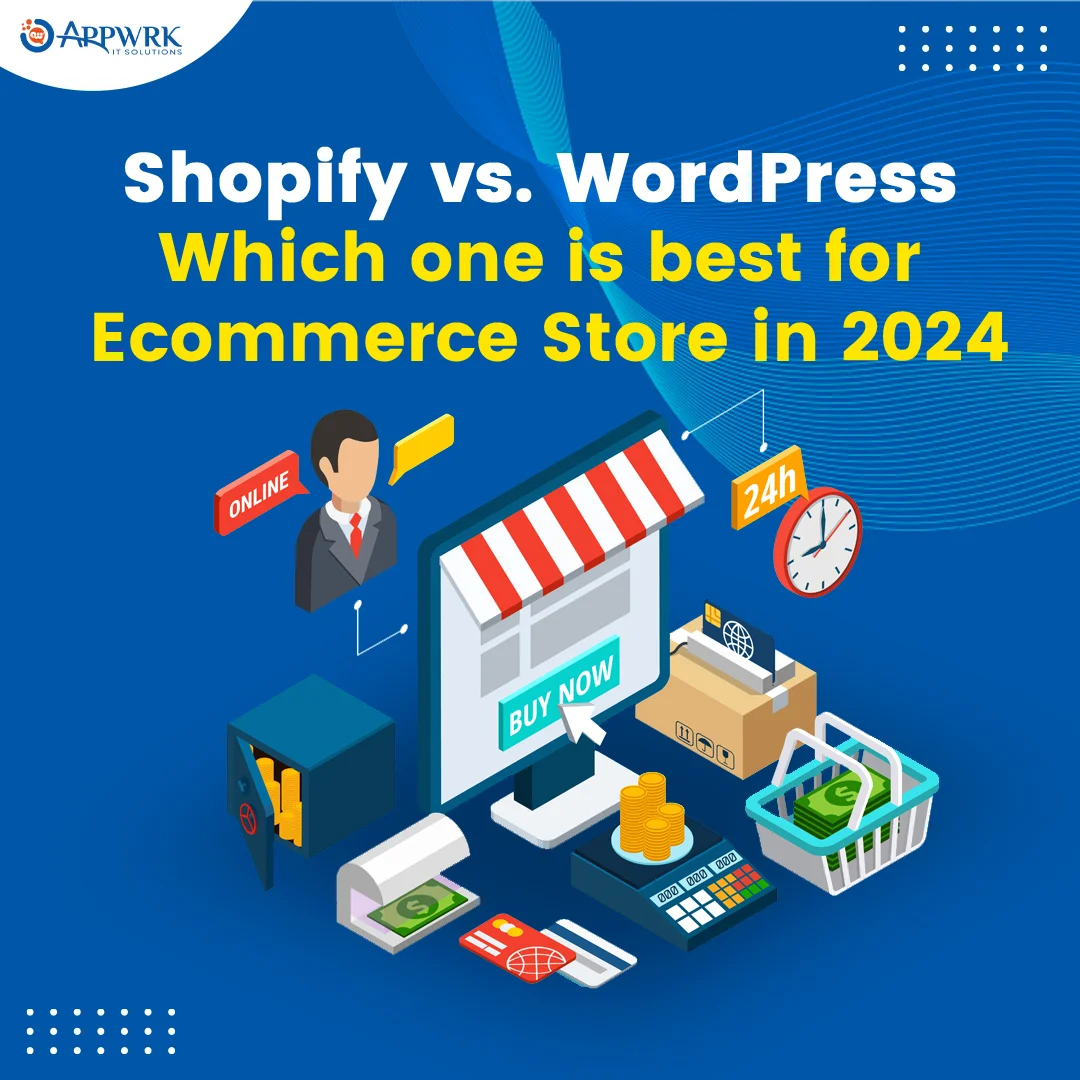

 Free Quote
Free Quote
















































